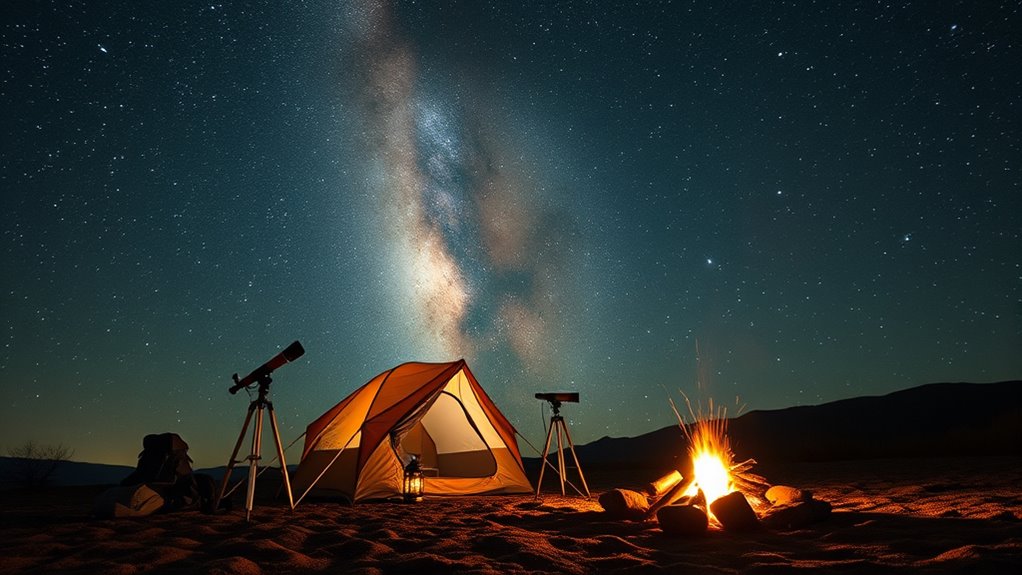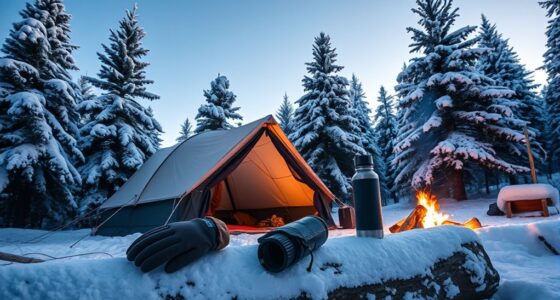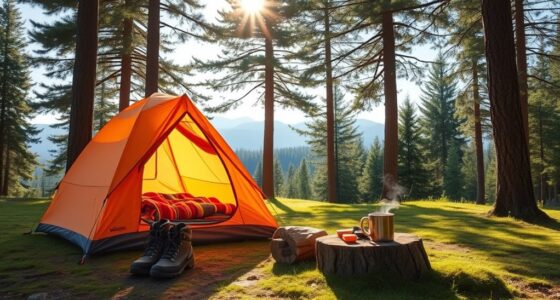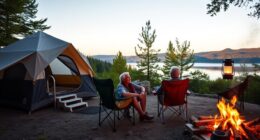To plan a stargazing camping trip, start by researching local regulations, permits, and dark sky zones to guarantee compliance and minimize light pollution. Choose remote sites with stable ground and an unobstructed sky view, ideally far from city lights. Prepare your astrophotography gear carefully—tripods, manual cameras, wide lenses—and practice adjusting exposures, focus, and stacking images for clarity. Patience, technical skill, and site awareness are key; exploring further will reveal more tips for a successful night-sky adventure.
Key Takeaways
- Research local laws and secure permits for overnight camping in designated dark sky zones.
- Choose remote campsites with minimal light pollution for optimal stargazing conditions.
- Pack essential astrophotography gear, including a sturdy tripod, fast lens, and manual camera settings.
- Plan to set up in a stable, sheltered spot with an unobstructed view of the night sky.
- Practice patience and test camera settings to capture clear, detailed images of celestial objects.
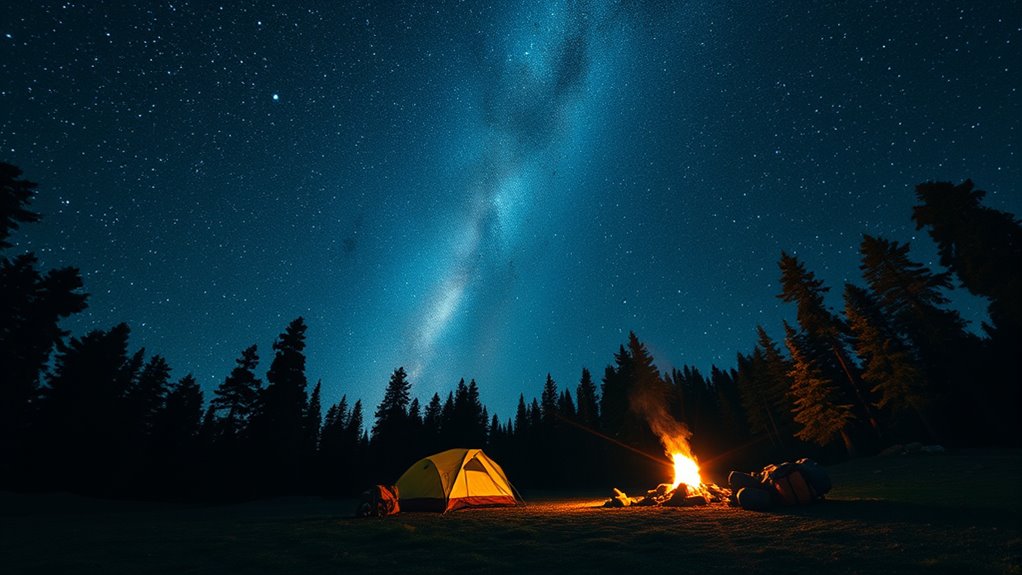
Night‑Sky Tourism has gained popularity as more people seek immersive experiences beyond city lights, venturing into remote locations with ideal conditions for stargazing. When planning your stargazing camping trip, understanding astrophotography techniques can substantially enhance your experience, allowing you to capture breathtaking images of celestial objects. To do this effectively, you’ll need a sturdy tripod, a camera with manual settings, and a fast lens with a wide aperture. Practice adjusting exposure times carefully—typically between 10 to 30 seconds—to prevent star trails unless intentionally desired. Use a low ISO setting to reduce noise, and experiment with focus, often by manually focusing on a bright star or distant light to ensure pinpoint clarity. Additionally, employing techniques like stacking multiple images can improve clarity and detail, giving you a richer, more detailed photograph of the night sky.
Before you set out, it’s essential to research local stargazing laws in the area you plan to visit. Some regions have restrictions on the use of artificial lights, drones, or even the time frame for camping activities after sunset. Respect these laws to avoid fines or disturbances and to preserve the natural environment for future stargazers. Many parks or protected areas require permits for overnight camping or have designated dark sky zones, so verify these details beforehand. Being aware of local regulations also helps you plan your nighttime activities responsibly, ensuring that your photography and observation efforts do not interfere with wildlife or other visitors.
Choosing your campsite with these factors in mind will also improve your experience. Opt for locations with minimal light pollution, away from urban centers and illuminated facilities. Once you arrive, set up your gear in a stable, sheltered spot that offers a clear, unobstructed view of the sky. Adjust your camera settings patiently, taking test shots and reviewing them on your camera’s display. Remember, astrophotography is as much about patience as it is about technique; sometimes it takes several attempts to get that perfect shot. Keep your equipment ready and your mind focused on the night sky’s subtle shifts. With careful preparation, adherence to local laws, and mastery of astrophotography techniques, your stargazing camping trip will not only deepen your appreciation of the cosmos but also produce stunning images to cherish long after the stars have moved across the sky.
Frequently Asked Questions
What Are the Best Months for Stargazing in Different Regions?
You’ll find ideal stargazing months vary by region, typically during new moon phases when the sky is darker. In the Northern Hemisphere, late fall and winter offer clear skies, while the Southern Hemisphere favors May through August. Pay attention to celestial events like meteor showers and planetary alignments, which often peak during these months. Planning around moon phases guarantees minimal moonlight interference, enhancing your stargazing experience.
How Do I Choose the Right Camping Gear for Stargazing?
Choose your camping gear wisely by prioritizing comfort, durability, and functionality. Focus on gear essentials like a high-quality sleeping bag suited for the forecasted temperatures, a sturdy tent with good ventilation, and a comfortable sleeping pad for support. Add a reliable headlamp with red light to preserve night vision, warm clothing layers, and a portable chair. This careful selection guarantees you stay cozy, prepared, and fully immersed in the awe of the night sky.
Are There Any Safety Tips for Night-Time Wildlife Encounters?
During wildlife encounters at night, stay calm and avoid sudden movements to prevent alarming animals. Keep a safe distance, use red flashlight filters to minimize disturbance, and carry bear spray if in bear country. Always store food securely away from your tent, and avoid attracting animals with scents. Follow safety precautions like making noise periodically to alert wildlife of your presence, ensuring both your safety and theirs during your stargazing adventure.
How Can I Minimize Light Pollution During My Trip?
To minimize light pollution during your trip, you should turn off all unnecessary outdoor lights, use red or amber filters to reduce glare, and position your campsite away from artificial sources. Practice dark sky preservation by choosing locations with minimal urban influence and utilizing light pollution mitigation techniques like shielding lights and using low-intensity bulbs. These steps help preserve the night sky’s natural beauty, ensuring ideal stargazing conditions for everyone.
What Local Regulations Should I Be Aware of When Camping?
You should check campground permits and fire restrictions before camping. Obtain necessary permits from local authorities, ensuring your site is authorized for overnight stays. Review fire restrictions carefully; some areas prohibit open flames or may require a fire permit. Follow posted guidelines to prevent wildfires, and always have a fire extinguisher nearby. Staying informed helps you avoid fines and keeps the environment safe for stargazing and future visitors.
Conclusion
As you finalize your stargazing camping trip, remember that meticulous planning transforms a simple night under the stars into an awe-inspiring experience. Double-check your gear, monitor weather forecasts, and choose a location with minimal light pollution. Patience is your best companion—like a telescope patiently focusing on distant galaxies. With careful preparation and an attentive eye, you’ll discover the universe’s secrets, turning your night sky adventure into a celestial symphony played just for you.

